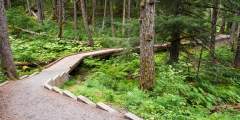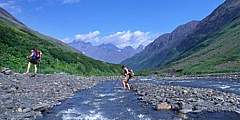The Iditarod National Historic Trail is Alaska’s sole National Historic Trail. This network of 2,300-mile winter trails evolved to connect Alaskan Native villages, established the dog-team mail and supply route during Alaska’s Gold Rush, and now serves as a vital recreation and travel link.
Much of the trail is not passable without snow cover, at least without webbed feet and serious mosquito repellent. However, there are several sections in the Kenai Peninsula and along the coast in Nome that are accessible for year-round hiking:
- From Seward’s Iditarod Monument, you can walk north along a paved bike path along Resurrection Bay
- Just north of Seward (mile 2.1 of the Seward Highway) at Nash Road, you can access a mostly-flat section of the trail to Bear Lake, 4 miles away. In the winter, Bear Lake is groomed for cross-country skiing and snowmachining
- A popular mountain-bike route, the Johnson Pass Trail, affords alpine and waterfall views as well as a workout over a 24-mile one-way trek
- From Alyeska in Girdwood, the Winner Creek Trail offers well-maintained access to the trail for the first few miles, with the option to extend into remote valleys via the Upper Winner Creek and Twentymile Trails
- Up Crow Creek Road in Girdwood, much of the popular, challenging Crow Pass Trail follows the historic Iditarod Trail.
During mail route days, mushers relied on roadhouses throughout the Iditarod Trail system. Today, several public shelter cabins are maintained along the trail.






